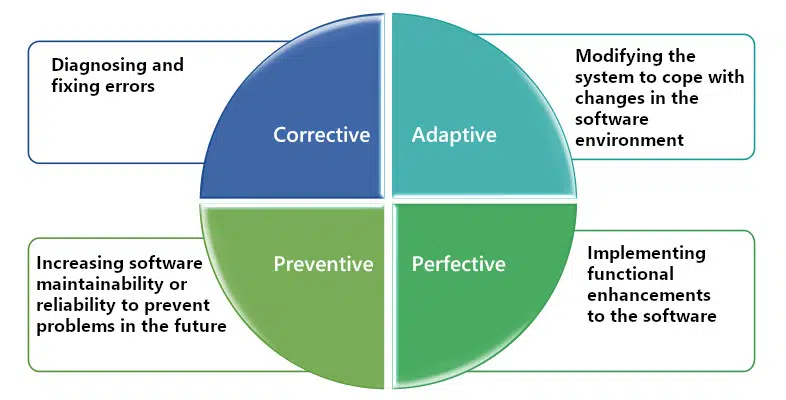The Importance of Ongoing Support and Maintenance in Software Development Projects
In the fast-evolving tech world, software maintenance ensures applications remain efficient, secure, and aligned with business goals. Beyond fixing bugs, it includes enhancing features and optimizing performance to meet changing user demands. Studies reveal that up to 60% of IT budgets go toward maintaining existing systems, underscoring its strategic importance.
Savvycom, a trusted software development company, offers expert maintenance solutions to help businesses stay competitive and future-ready. Read on to uncover the critical role of software maintenance in driving long-term success.

Understanding Software Maintenance
What is Software Maintenance?
Software maintenance involves the activities required to keep software operational after its initial release. These activities include fixing bugs, updating software to accommodate changes in the environment, improving performance, and ensuring the software continues to meet user needs.
Types of Software Maintenance

4 types of software maintenance (Source: Nexus)
- Corrective Maintenance: Involves fixing bugs and errors that are discovered after the software has been deployed.
- Adaptive Maintenance: Involves updating the software to work with changes in the software environment, such as new operating systems or hardware.
- Perfective Maintenance: Focuses on improving and enhancing the software to increase performance or add new features.
- Preventive Maintenance: Aims to identify and fix potential issues before they become significant problems.
The Critical Role of Software Maintenance in Business Success
Enhancing System Reliability and Uptime
Regular software maintenance minimizes the risk of unexpected system failures, ensuring that critical operations remain uninterrupted. This is particularly important for industries such as BFSI and healthcare, where downtime can result in significant financial and reputational losses. Ensuring a high uptime not only improves service delivery but also builds trust with customers.
Reducing Technical Debt
Technical debt accumulates when systems are not regularly maintained or updated. Over time, outdated software can lead to increased complexity, higher costs, and decreased agility. By investing in software maintenance, organizations can mitigate technical debt, ensuring that their systems remain robust and adaptable to new challenges.
Driving Innovation and Future-Proofing
Effective software maintenance is not just about fixing bugs—it’s about setting the stage for innovation. By continuously updating and improving your systems, you ensure they remain competitive and capable of supporting new business models. This forward-thinking approach is essential for staying ahead in a rapidly evolving digital landscape.
Increasing Productivity and Efficiency
Automating routine maintenance tasks frees up IT teams to focus on strategic initiatives and innovation. Organizations that invest in proactive maintenance strategies report significant productivity gains. For instance, a Fortune 500 company observed a 30% increase in operational efficiency after implementing an automated maintenance framework.
Ensuring Data Security and Regulatory Compliance
Data breaches and regulatory non-compliance can be extremely costly. Regular software maintenance ensures that security patches are applied promptly, vulnerabilities are addressed, and systems comply with evolving regulatory standards. This not only protects sensitive information but also minimizes the risk of legal and financial penalties.
Key Strategies for Effective Software Maintenance
1. Develop a Comprehensive Maintenance Plan
A proactive maintenance plan is essential for managing software maintenance effectively. Start by defining clear objectives, such as reducing downtime, improving system performance, and ensuring regulatory compliance. Establishing key performance indicators (KPIs) helps measure success and guides continuous improvement.
Example:
A global manufacturing firm implemented a maintenance plan that included regular system audits and performance reviews. This approach reduced system failures by 30% and improved overall productivity by 20%.
2. Implement Automated Monitoring and Testing
Automation is a game-changer in software maintenance. Automated monitoring tools can track system performance, detect anomalies, and trigger alerts when issues arise. Similarly, automated testing frameworks help ensure that updates or patches do not disrupt existing functionalities.
Real-World Data:
According to a report by Forrester, companies that utilize automated testing during maintenance cycles experience a 40% reduction in post-deployment defects.
3. Prioritize Preventive Maintenance
Preventive maintenance involves regular system reviews and updates to identify and resolve issues before they impact operations. This includes applying security patches, updating libraries, and optimizing code. A preventive approach can extend the lifespan of a system and prevent costly emergency fixes.
Statistic:
The Standish Group reports that preventive maintenance can reduce the total cost of software ownership by up to 25%.
4. Foster a Culture of Continuous Improvement
Encourage a culture where continuous improvement is a core value. Solicit feedback from end-users, monitor performance metrics, and conduct regular training sessions for your IT team. This proactive approach ensures that the software evolves with business needs and technological advancements.
Example:
A healthcare provider that integrated continuous feedback mechanisms into its maintenance strategy observed a 15% improvement in patient satisfaction, thanks to faster resolution of software issues.
5. Leverage External Expertise
Automation tools can significantly enhance the efficiency of support and maintenance activities. These tools can automate repetitive tasks such as monitoring, testing, and deploying updates, allowing the support team to focus on more critical issues. Leveraging an AI-powered documentation generator can further streamline maintenance workflows by automatically creating and updating technical documents, release notes, and user guides—saving time while ensuring accuracy and consistency across software updates.

Continuous support and maintenance ensure the software’s effectiveness
Case Studies on the Importance of Ongoing Support and Maintenance
Case Study 1: Enhancing Security for a Healthcare Application
Challenge: A healthcare application developed for a US-based client required ongoing support to maintain high security standards and comply with regulatory requirements.
Solution: The software development company implemented a proactive maintenance plan that included regular security updates, performance monitoring, and periodic reviews. Automated tools were used to streamline the update process and ensure compliance.
Outcome: The application remained secure and compliant with regulatory standards, and performance issues were minimized. Regular updates enhanced user satisfaction and trust.
Case Study 2: Adapting an E-commerce Platform to Market Changes
Challenge: An e-commerce platform for a leading retailer in Singapore needed to adapt to rapidly changing market trends and customer expectations.
Solution: The software development company provided continuous support, including adaptive maintenance to incorporate new features and improvements based on customer feedback. Regular performance reviews were conducted to ensure optimal functionality.
Outcome: The e-commerce platform remained competitive and responsive to market changes, leading to increased user engagement and sales.
Case Study 3: Sustaining a Financial Management System
Challenge: A financial management system for a Thai enterprise required ongoing support to ensure data integrity and system reliability.
Solution: The software development company established a comprehensive maintenance plan that included preventive measures, regular updates, and a robust monitoring system. This proactive approach minimized downtime and enhanced system reliability.
Outcome: The financial management system consistently met performance expectations and maintained high data integrity, which was crucial for the client’s operations.
Frequently Asked Questions
Why is ongoing support important in software development?
Ongoing support is crucial to ensure that software remains functional, secure, and up-to-date. It helps in fixing bugs, enhancing performance, and adapting to changing requirements, ultimately ensuring the long-term success of the software.
What are the different types of software maintenance?
There are four main types of software maintenance: corrective (fixing bugs), adaptive (updating for new environments), perfective (improving performance or adding features), and preventive (addressing potential issues before they arise).
How can regular updates and patches benefit my software?
Regular updates and patches keep your software secure, fix bugs, and improve performance. They ensure that your software remains compatible with new technologies and meets user expectations.
How does a proactive maintenance culture benefit a software development project?
A proactive maintenance culture helps in early identification and resolution of issues, preventing major breakdowns and reducing long-term costs. It promotes continuous improvement and ensures that the software remains efficient and reliable.
Why should I choose Savvycom for my software maintenance needs?
Savvycom is a top 10 IT provider in Vietnam, known for delivering value-for-money tech solutions. We offer comprehensive support and maintenance services, ensuring your software remains secure, efficient, and up-to-date. Our expertise spans various industries, including healthcare, e-commerce, and finance.
For more information of effective Software Maintenance notes, watch this video:
Conclusion
Ongoing software maintenance and support are vital components of any successful software development project. By investing in these software development services, businesses can ensure their software remains reliable, secure, and adaptive to changing needs, thereby achieving long-term success.
Tech Consulting, End-to-End Product Development, Cloud & DevOps Service! Since 2009, Savvycom has been harnessing digital technologies for the benefit of businesses, mid and large enterprises, and startups across the variety of industries. We can help you to build high-quality software solutions and products as well as deliver a wide range of related professional services.
Savvycom is right where you need. Contact us now for further consultation:
- Phone: +84 24 3202 9222
- Hotline: +1 408 663 8600 (US); +612 8006 1349 (AUS); +84 32 675 2886 (VN)
- Email: [email protected]


